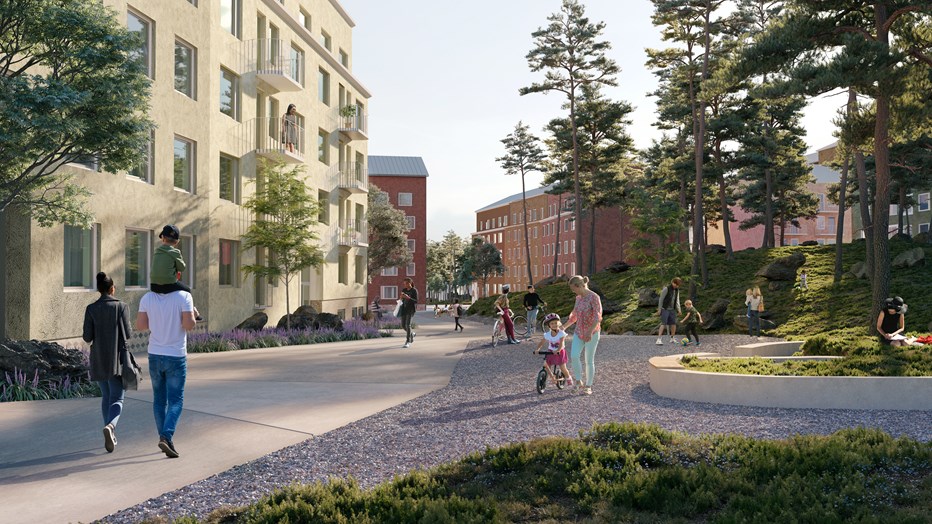A uniting green neighborhood takes shape
In Kista, north of Stockholm, the new neighborhood Kista Parkstad will emerge in a unique park environment with great natural and cultural values. Approximately 1,500 homes are planned here. The existing building called Ormen Långe, will house apartment hotels, shared apartments, co-working, sports halls, preschools, commercial activities and more. With its 25,000 square meter the building will have room for many different activities.
Skanska is developing the area together with the real estate company Areim in a Joint Venture. The neighborhood will be built over a period of 10-15 years and is made possible by a new detailed development plan for the Kv Odde area.
One of the overall goals of the development of the area is that social sustainability should play a central role. The project has been one of the first in the City of Stockholm to work with social value-creating analysis as a guiding star. The project's vision is to become a district that connects the physical structures with new pedestrian paths and buildings, but also the social networks through target points and meeting places for the new residents and those who already live and work in the immediate area.
Ormen långe - IBM's first Swedish office
IBM's first Swedish office facility is located in the area. The office, designed by architects Bengt Lindroos and Carl Nyrén, was built in 1978 and is carefully adapted to the existing natural landscape.
The brick building winds its way through the landscape like a snake and the main building has therefore been named Ormen Långe (the long snake). The entire office facility together with the landscape has a high cultural-historical and architectural value. IBM moved from these premises in 2016. The project's central goal is to create a meeting place and destination in the middle of this environment, for the new residents, businesses and residents in nearby areas.
A neighborhood with a mix
The existing buildings will be transformed and adapted for new housing concepts and activities, in order to make the best use of the cultural heritage that accompanies the area's history and architecture. In addition to this, nine new residential blocks, a square and two parks are planned. Four of these blocks will consist of rental apartments, one of which will also contain student housing, and five blocks will have condominiums.
To ensure that there is childcare for all children, three preschools are planned. The outdoor environment of the preschools will be integrated in the natural landscape.
It is no coincidence that the district will be called Kista Parkstad (Kista Park City). The area's existing natural landscape is characteristic; it was an important ingredient when IBM built their facility in 1978 and will continue to be so in the future. Nature will be present everywhere in Kista Parkstad.
A better neighborhood with the help of dialogue
Sustainability work has been central to the project from the start. Goals have been set in all three areas of sustainability – green, social and economic sustainability. The social value-creating work began early. Dialogues with children and young people, as well as the local business community and civil society have been used in various ways to gain knowledge about the area's existing qualities, but also about what needs Kista Parkstad can help fulfill.
With the environment, climate and health in focus
Urban planning for an area that will be ready in 10 to 15 years at the earliest, requires smart thinking from the start. Flexible solutions for mobility have been developed and bicycles are allowed to take up a lot of space. By combining a solution of classic underground garages, converting an existing data center into a parking garage and creating a so-called mobility hub, the district is given flexibility to keep up with society's changes regarding various means of transport. In the mobility hub, residents will be able to repair their bikes, rent a freight bicycle or electric moped and pick up their food deliveries in the specially adapted coolers. Everything aims to encourage residents to choose alternative means of transport instead of cars.
Preserving natural landscape is central to Kista Parkstad. Nature is part of the neighborhood’s identity and it contributes to a better microclimate. Nature benefits biodiversity and wildlife. For example, the residential area has been adapted to benefit birds' flight paths. Another example is that the salamanders' environment in the marsh will be maintained by leading stormwater to the area.
Green sustainability is very important in our choices of building material and working methods. We plan for a green and sustainable production with a low climate impact. All new residential blocks are intended to be environmentally certified.
A safe neighborhood
Early in the planning process, a Social Value Creation Analysis was established, which has since permeated the work in urban planning. This is the basis for the entire detailed development plan for the area. Safety, which is the cornerstone of this work, has affected everything from the planning of entrances, location of premises, park environments, lighting and window placement towards the streets. In Kista Parkstad you should feel seen, even during the darkest time of the year.
With local life and residents in focus
An important part of creating economic sustainability is to provide good conditions for a mixed city. This means that we not only plan for housing, but also provide space for other activities that both generate jobs and contribute with a customer base for businesses such as cafés or flower shops. The more mix we create, the greater economic sustainability is obtained in the area, which in turn has a synergy effect on social sustainability. With the residents in focus, we offer different forms of housing in the area so that a diversity of people can live in Kista Parkstad.

